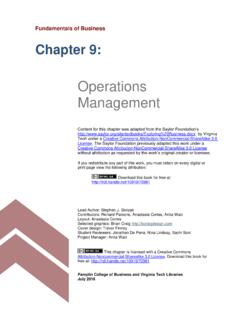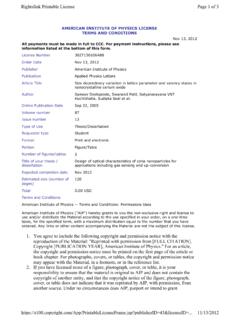Transcription of Management and Leadership - Virginia Tech
1 Fundamentals of Business Chapter 7: Management and Leadership Content for this chapter was adapted from the Saylor Foundation s by Virginia tech under a Creative Commons Attribution-NonCommercial-ShareAlike License. The Saylor Foundation previously adapted this work under a Creative Commons Attribution-NonCommercial-ShareAlike License without attribution as requested by the work s original creator or licensee. If you redistribute any part of this work, you must retain on every digital or print page view the following attribution: Download this book for free at: Lead Author: Stephen J.
2 Skripak Contributors: Anastasia Cortes, Anita Walz Layout: Anastasia Cortes Selected graphics: Brian Craig Cover design: Trevor Finney Student Reviewers: Jonathan De Pena, Nina Lindsay, Sachi Soni Project Manager: Anita Walz This chapter is licensed with a Creative Commons Attribution-Noncommercial-Sharealike License. Download this book for free at: Pamplin College of Business and Virginia tech Libraries July 2016 [This page intentionally left blank] Chapter 7 Download this book for free at: 159 Chapter 7 Management and Leadership Learning Objectives 1) Identify the four interrelated functions of Management : planning, organizing, leading, and controlling.
3 2) Understand the process by which a company develops and implements a strategic plan. 3) Explain how managers direct others and motivate them to achieve company goals. 4) Describe the process by which a manager monitors operations and assesses performance. 5) Explain what benchmarking is and its importance for managing organizations. 6) Describe the skills needed to be a successful manager. 160 Download this book for free at: Chapter 7 Noteworthy Management Consider this scenario: you re halfway through the semester and ready for midterms.
4 You open your class notes and declare them pathetic. You regret scribbling everything so carelessly and skipping class so many times. That s when it hits you: what if there was a note-taking service on campus? When you were ready to study for a big test, you could buy complete and legible class notes. You ve heard that there are class-notes services at some larger schools, but there s no such thing on your campus. So you ask yourself, why don t I start a note-taking business? Your upcoming set of exams may not be salvageable, but after that, you d always have great notes.
5 And in the process, you could learn how to manage a business (isn t that what majoring in business is all about?). You might begin by hiring a bunch of students to take class notes. Then the note takers will e-mail them to your assistant, who ll get them copied (on a special type of paper that can t be duplicated). The last step will be assembling packages of notes and, of course, selling them. You decide to name your company Notes-4-You. It sounds like a great idea, but you re troubled by one question: why does this business need you?
6 Do the note takers need a boss? Couldn t they just sell the notes themselves? This process could work, but it would work better if there was someone to oversee the operations: a manager to make sure that the operations involved in preparing and selling notes were performed in both an effective and an efficient manner. You d make the process effective by Figure : Management requires you to be both efficient and effective. Chapter 7 Download this book for free at: 161 ensuring that the right things got done and that they all contributed to the success of the enterprise.
7 You d make the process efficient by ensuring that activities were performed in the right way and used the fewest possible resources. What Do Managers Do? The Management Process The effective performance of your business will require solid Management : the process of planning, organizing, leading, and controlling resources to achieve specific goals. A plan enables you to take your business concept beyond the idea stage. It does not, however, get the work done. For that to happen, you have to organize things effectively.
8 You ll have to put people and other resources in place to make things happen. And because your note-taking venture is supposed to be better off with you in charge, you need to be a leader who can motivate your people to do well. Finally, to know whether things are in fact going well, you ll have to control your operations that is, measure the results and compare them with the results that you laid out in your plan. Figure summarizes the interrelationship between planning and the other functions that managers perform.
9 This chapter will explore planning, leading, and controlling in some detail. Organizing is an especially complex topic, and will be discussed in Chapter 8. Figure : The Management Process 162 Download this book for free at: Chapter 7 Planning Without a plan, it s hard to succeed at anything. The reason is simple: if you don t know where you re going, you can t move forward. Successful managers decide where they want to be and then figure out how to get there; they set goals and determine the best way to achieve them.
10 As a result of the planning process, everyone in the organization knows what should be done, who should do it, and how to do it. Developing a Strategic Plan Coming up with an idea say, starting a note-taking business is a good start, but it s only a start. Planning for it is a step forward. Planning begins at the highest level and works its way down through the organization. Step one is usually called strategic planning: the process of establishing an overall course of action. To begin this process, you should ask yourself a couple of very basic questions: why, for example, does the organization exist?


















